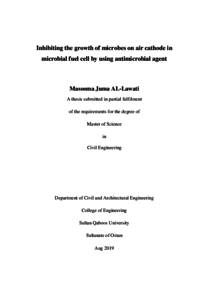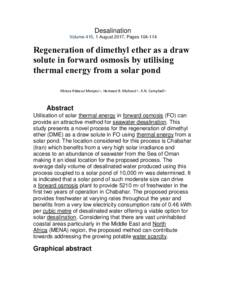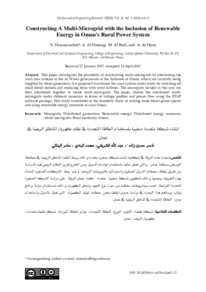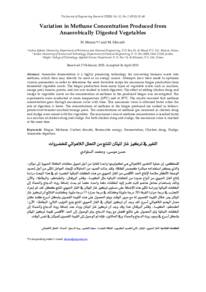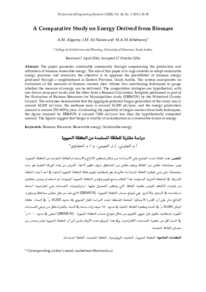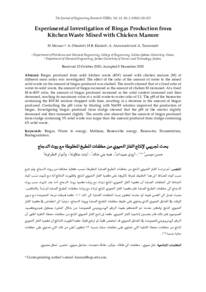Document
Inhibiting the growth of microbes on air cathode in microbial fuel cell by using antimicrobial agent.
Publisher
Sultan Qaboos University
Gregorian
2019
Language
English
Subject
English abstract
As a promising technology for renewable energy production and wastewater treatment, microbial fuel cell (MFC) is quite new and significantly important. The conventional two chamber MFC consisted of an anaerobic biological anode and aerobic biological/abiotic cathode separated by proton exchange membrane. On bio-anode, organic compounds were oxidized by microbes to produce proton (H+), electron and carbon dioxide. H+ diffused to cathode, electron travelled through outer circuit to cathode, where they combined with oxygen to form water. The cost of membrane and aeriation device and the internal resistance were the main limitation of a conventional two chamber MFC. To eliminate the aeration device and reduce the internal resistance, air-cathode single chamber MFC (SCMFC) was introduced. SCMFC was simple in design and cost-effective. However, formation of aerobic biofilm on air-cathode fouled the attached Pt-catalysts on it and subsequently reduced the system performance. Therefore, a suitable mitigation measure was essential to suppress the growth of biofouling on cathode for cost-effective application of MFC in wastewater treatment and bio-energy recovery. The current study carried
out to investigate the effectiveness of chloramphenicol as anti-biofouling agent on Pt-coated cathode to suppress the growth of aerobic biofilm in SCMFC operated in batch mode and compared the findings with a similar conventional SCMFC with Pt-coated air-cathode. The study was done by using two MFCs, i.e., one with conventional Pt-coated air-cathode (MFC-1) as
control, and another with antibiotic mixed Pt-coated air-cathode (MFC-2). In the control MFC-1, the maximum generated cell potential of 0.82 V reduced to 0.62 V during three months operation due to biofouling development on Pt-coated air-cathode. Besides, the control system achieved 95% COD removal by 5 days hydraulic retention time (HRT). However, with the newly developed antibiotic mixed Pt-coated cathode in MFC-2, the system achieved maximum cell potential of 0.85V with 95% COD removal by 10 days HRT. The higher HRT in MFC-2 demonstrated that there were no/less-aerobic biofilm grown on the cathode. Therefore, the rate of COD removal was slower compared to that in the control MFC-1 where two different groups of biofilm were involved in reducing the COD. The maximum columbic efficiency (CE) achieved in control MFC-1 was 8%, whereas, the maximum CE achieved in newly developed MFC-2 was 12.5%. A significantly high CE in MFC-2 explained that the major fraction of COD was removed by the exo-electrogenic microbes on anode that were contributed to higher CE generation. The increment in CE by applying antibiotic on cathode indicated the absence of cathodic aerobic biofilm and the removal of COD was solely done by the anodic biofilm. Therefore, the application of antibiotic coating on cathode can suppress the growth of cathodic biofouling without interfering the other bio- electrochemical properties (COD removal, power recovery, pH change) of the system. However, the release of antibiotic chemicals from cathode to electrolyte could negatively affect the anodic
biofilm performance in the long-term operation. Therefore, more studies were needed for long- term investigation with this antibiotic coated cathode or exploring the application of other antibiotics on cathode to make the system cost-effective and ecofriendly.
Member of
Resource URL
Arabic abstract
تكنولوجيا واعدة لإنتاج الطاقة المتجددة ومعالجة مياه الصرف الصحي، تعد خلية الوقود الميكروبية (MFC) جديدة تماما وذات أهمية
كبيرة. تتكون الخلية التقليدية من انود حيوي لاهوائي وكاتود حلوي/ غير حيوي هوائي مفصولان بعشاء تبادل الإلكترونات يتم اكسدة
المركبات العضوية الموجودة على الاتود بواسطة الميكروبات الإنتاج البروتونات، الالكترونات والغاز ثاني أكسيد الكربون. تنتشر البروتونات لتصل الى الكاثود، كما تنتقل الالكترونات عن طريق الدائرة الكهربائية ليتم دمجهم مع الأكسجين لتكوين الماء تكلفة العشاء والتهوية وزيادة المقاومة الداخلية هي القيود الأساسية للخلية التقليدية للتخلص من التهوية وتقليل المقاومة، تم استخدام خلية ذات الكائود الهوائی. حيث انها بسيطة في التصميم وكذلك فعاله من حيث التكلفة. ولكن فان تشكل غشاء البكتيريا الحيوي على الكاثود يعلق عملية التحفيز في الطبقة المحفزة الموجودة على الكاثود وبالتالي يقلل من اداء النظام. لذلك، لابد من اتباع طريقة للتقليل من تشكل البكتيريا الهوائية على الكانود وتكون فعالة من حيث التكلفة المعالجة مياه الصرف الصحي واستخدامها في انتاج الطاقة الحيوية اجريت الدراسة الحالية لمعرفة مدى فعالية الكلورامفينيكول كمضاد حيوي لمنع نمو البكتيريا الهوائية في الخلية الأحادية على الكانود وتم مقارنة النتائج مع الخلية التقليدية التي تحتوي على الكاثود المغلف بالبلاتينيوم. وقد اجريت الدراسة باستخدام خليتين، أحدهما بالكاثود التقليدي المغلف بالبلاتينيوم والخلية الأخرى تحتوي على كاتود مغلف بالمضاد الحيوي. حيث تناقصت الكهرباء المتولدة من 0 . 82 فولت الى 0 . 62 فولت خلال ثلاثة أشهر من التشغيل وذلك بسبب تكون طبقة البكتيريا الهوائية على الكاثود المغلف بالبلاتينيوم، كما تمكنت الخلية من ازالة 95% من المركبات الكيميائي خلال خمسة ايام. ولكن انتجت الخلية ذات الكاثود المغلف بالمضاد الحيوي كهرباء تصل إلى 0 . 85 فولت وتمكنت من ازالة 95% من المركبات الكيميائية خلال عشرة أيام.
استهلاك عشرة ايام في الخلية ذات الكاثود المغلف بالمضاد الحيوي دليل على عدم وجود البكتيريا الهوائية على الكاثود لذلك كان معدل ازالة المركبات الكيميائية بطيء مقارنة بالخلية ذات الكاتود المغلف بالبلاتينيوم. حيث في الخلية الأخيرة شارك نوعان من البكتيريا في ازالة المركبات الكيميائية تصل الكفاءة في الخلية ذات البلاتينيوم الى 8%، في حين انها تصل إلى 12. 5 % في الخلية ذات المضاد الحيوي. حيث تشير النتائج أن المركبات الكيميائية الموجودة تمت ازالتها فقط بالبكتيريا اللاهوائية الموجودة على الأنود لذلك حققت كفاءة عالية أن ارتفاع الكفاءة دليل على غياب البكتيريا الهوائية التي تشكل على الكانود وتمت ازالة المركبات الكيميائية باستخدام البكتيريا الموجودة على الأنود فقط لذلك يمكن يؤدي تطبيق المضاد الحيوي على الكاتود الى منع تكون البكتيريا الهوائية دون التأثير على الخواص الكهروكيميائية الأخرى للنظام (ازالة المركبات الكيميائية، استعادة الطاقة، وتغيير الرقم الهيدروجيني). ومع ذلك فان تسريب المضادات الحيوية الى الوسط الغذائي يمكن أن يؤثر سلبا على عمل البكتريا الموجودة على الأنود في العمليات الطويلة الأجل لذلك هناك حاجة لمزيد من الدراسات للتحقق على المدى الطويل من فعالية هذا النوع من المضاد الحيوي وكذلك تجربة انواع اخرى من المضادات الحيوية لتغليف الكاتود لجعل النظام فعال من حيث التكلفة وكذلك صديق للبيئة.
كبيرة. تتكون الخلية التقليدية من انود حيوي لاهوائي وكاتود حلوي/ غير حيوي هوائي مفصولان بعشاء تبادل الإلكترونات يتم اكسدة
المركبات العضوية الموجودة على الاتود بواسطة الميكروبات الإنتاج البروتونات، الالكترونات والغاز ثاني أكسيد الكربون. تنتشر البروتونات لتصل الى الكاثود، كما تنتقل الالكترونات عن طريق الدائرة الكهربائية ليتم دمجهم مع الأكسجين لتكوين الماء تكلفة العشاء والتهوية وزيادة المقاومة الداخلية هي القيود الأساسية للخلية التقليدية للتخلص من التهوية وتقليل المقاومة، تم استخدام خلية ذات الكائود الهوائی. حيث انها بسيطة في التصميم وكذلك فعاله من حيث التكلفة. ولكن فان تشكل غشاء البكتيريا الحيوي على الكاثود يعلق عملية التحفيز في الطبقة المحفزة الموجودة على الكاثود وبالتالي يقلل من اداء النظام. لذلك، لابد من اتباع طريقة للتقليل من تشكل البكتيريا الهوائية على الكانود وتكون فعالة من حيث التكلفة المعالجة مياه الصرف الصحي واستخدامها في انتاج الطاقة الحيوية اجريت الدراسة الحالية لمعرفة مدى فعالية الكلورامفينيكول كمضاد حيوي لمنع نمو البكتيريا الهوائية في الخلية الأحادية على الكانود وتم مقارنة النتائج مع الخلية التقليدية التي تحتوي على الكاثود المغلف بالبلاتينيوم. وقد اجريت الدراسة باستخدام خليتين، أحدهما بالكاثود التقليدي المغلف بالبلاتينيوم والخلية الأخرى تحتوي على كاتود مغلف بالمضاد الحيوي. حيث تناقصت الكهرباء المتولدة من 0 . 82 فولت الى 0 . 62 فولت خلال ثلاثة أشهر من التشغيل وذلك بسبب تكون طبقة البكتيريا الهوائية على الكاثود المغلف بالبلاتينيوم، كما تمكنت الخلية من ازالة 95% من المركبات الكيميائي خلال خمسة ايام. ولكن انتجت الخلية ذات الكاثود المغلف بالمضاد الحيوي كهرباء تصل إلى 0 . 85 فولت وتمكنت من ازالة 95% من المركبات الكيميائية خلال عشرة أيام.
استهلاك عشرة ايام في الخلية ذات الكاثود المغلف بالمضاد الحيوي دليل على عدم وجود البكتيريا الهوائية على الكاثود لذلك كان معدل ازالة المركبات الكيميائية بطيء مقارنة بالخلية ذات الكاتود المغلف بالبلاتينيوم. حيث في الخلية الأخيرة شارك نوعان من البكتيريا في ازالة المركبات الكيميائية تصل الكفاءة في الخلية ذات البلاتينيوم الى 8%، في حين انها تصل إلى 12. 5 % في الخلية ذات المضاد الحيوي. حيث تشير النتائج أن المركبات الكيميائية الموجودة تمت ازالتها فقط بالبكتيريا اللاهوائية الموجودة على الأنود لذلك حققت كفاءة عالية أن ارتفاع الكفاءة دليل على غياب البكتيريا الهوائية التي تشكل على الكانود وتمت ازالة المركبات الكيميائية باستخدام البكتيريا الموجودة على الأنود فقط لذلك يمكن يؤدي تطبيق المضاد الحيوي على الكاتود الى منع تكون البكتيريا الهوائية دون التأثير على الخواص الكهروكيميائية الأخرى للنظام (ازالة المركبات الكيميائية، استعادة الطاقة، وتغيير الرقم الهيدروجيني). ومع ذلك فان تسريب المضادات الحيوية الى الوسط الغذائي يمكن أن يؤثر سلبا على عمل البكتريا الموجودة على الأنود في العمليات الطويلة الأجل لذلك هناك حاجة لمزيد من الدراسات للتحقق على المدى الطويل من فعالية هذا النوع من المضاد الحيوي وكذلك تجربة انواع اخرى من المضادات الحيوية لتغليف الكاتود لجعل النظام فعال من حيث التكلفة وكذلك صديق للبيئة.
Category
Theses and Dissertations

